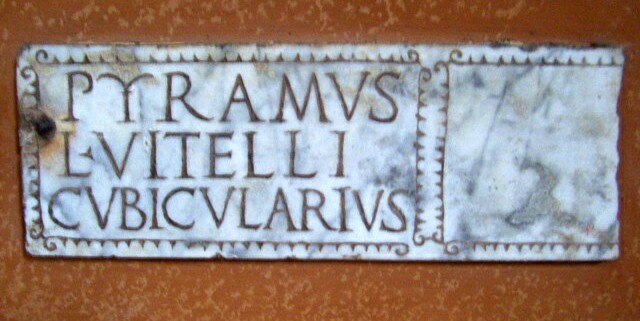Tituli picti dressel.jpg on:
[Wikipedia]
[Google]
[Amazon]

 :''See also Titulus (Roman Catholic) for Roman churches called tituli, or
:''See also Titulus (Roman Catholic) for Roman churches called tituli, or
File:9653 - Milano - Sant'Ambrogio - Bonamico Taverna in preghiera sec. XIII - Foto Giovanni Dall'Orto 25-Apr-2007.jpg, 14th-century Italian ''titulus'' records the identity of Bonamico Taverna, known only from this

 :''See also Titulus (Roman Catholic) for Roman churches called tituli, or
:''See also Titulus (Roman Catholic) for Roman churches called tituli, or titulus (disambiguation)
Titulus, the Latin word for "title", "label" or "inscription" (plural ''tituli'', normally italicized), may or may not be italicized as a foreign word, and may refer to:
* ''Titulus'', or Titular church, one of a group of Early Christian churches ...
for more meanings.''
''Titulus'' (Latin "inscription" or "label", the plural ''tituli'' is also used in English) is a term used for the labels or captions naming figures or subjects in art, which were commonly added in classical and medieval art
The medieval art of the Western world covers a vast scope of time and place, over 1000 years of art in Europe, and at certain periods in Western Asia and Northern Africa. It includes major art movements and periods, national and regional art, gen ...
, and remain conventional in Eastern Orthodox icons. In particular the term describes the conventional inscriptions on stone that listed the honours of an individual or that identified boundaries in the Roman Empire. A titulus pictus
A ''titulus pictus'' is an ancient Roman commercial inscription made on the surface of certain artefacts, usually the neck of an amphora. Typically, these inscriptions were made in red or black paint. The inscription specifies information such a ...
is a merchant's mark or other commercial inscription.
The sense of "title", as in "book title", in modern English derives from this artistic sense, just as the legal sense derives from plainer inscriptions of record.
Use in Western art
The increasing reluctance of the art of the West to use ''tituli'' was perhaps because so few people could read them in the Early Medieval period, and later because they reduced the illusionism of the image. Instead a system of attributes, objects identifying popular saints, was developed, but many such figures in Western art are now unidentifiable. This reluctance affected the choice of scenes shown in art; only those miracles of Jesus that were easily identifiable visually tended to be shown in cycles of the ''Life of Christ
The life of Jesus in the New Testament is primarily outlined in the four canonical gospels, which includes his genealogy and Nativity of Jesus, nativity, Ministry of Jesus, public ministry, Passion of Jesus, passion, prophecy, Resurrection of ...
''. Thus the '' Raising of Lazarus'' and '' Wedding at Cana'' are by far the most commonly shown miracles, and the healing miracles, visually easy to confuse, are neglected. The problems can clearly be seen in the small scenes of the Saint Augustine Gospels
The St Augustine Gospels (Cambridge, Corpus Christi College, Lib. MS. 286) is an illuminated Gospel Book which dates from the 6th century and is currently housed in the Parker Library in Corpus Christi College, Cambridge. It was made in Italy a ...
(late 6th century), where about 200 years after the manuscript was written ''tituli'' were added, which according to some art historians misidentify some scenes. Banderoles were a solution that became popular in the later Middle Ages, and in Northern Europe in the 15th century were sometimes used very extensively for speech, rather as in modern comics, as well as ''tituli''. These were abandoned as old-fashioned in the Renaissance, but increased respect for classical traditions led to continued use of Ancient Roman-style ''tituli'' where they were considered necessary, including on portraits.
Examples of tituli
*In the context of the Crucifixion, the ''titulus'' "" (and its translations in Aramaic and GreekJohn 19:20) is believed to have been affixed to Jesus' cross. ''INRI'' is the abbreviation for the above-mentioned Latin translation. See INRI and Titulus Crucis. *At the recovery of the coffin ofKing Arthur
King Arthur ( cy, Brenin Arthur, kw, Arthur Gernow, br, Roue Arzhur) is a legendary king of Britain, and a central figure in the medieval literary tradition known as the Matter of Britain.
In the earliest traditions, Arthur appears as a ...
at Glastonbury Abbey, at an opportune moment after a devastating fire in the 12th century, a lead cross of Arthur was alleged to have borne the explicit ''titulus'' "". The well-publicized discovery described by Giraldus Cambrensis, redoubled the pilgrimages to the Abbey.
Gallery
donor portrait
A donor portrait or votive portrait is a portrait in a larger painting or other work showing the person who commissioned and paid for the image, or a member of his, or (much more rarely) her, family. ''Donor portrait'' usually refers to the portr ...
File:Bayeux Tapestry (Harold).jpg, The 11th-century Bayeux Tapestry makes extensive use of ''tituli'' to explain the complicated story: "HIC RESIDET HAROLD REX ANGLORUM" and " STIGANT ARCHIEPS".
File:Triptych Harbaville Louvre OA3247 n4.jpg, Two "Saint Theodore"s are distinguished by ''tituli'' in the Byzantine Harbaville Triptych
File:Abbaye de la Chaise-Dieu, tapisserie flamande du début du XVIe siècle représentant la vie du Christ, commandée par Jacques de Saint-Nectaire.jpg, Extensive ''tituli'', and "speech-bubbles" on banderoles in this early 16th-century tapestry
Notes
References
* Emile Mâle, The Gothic Image: Religious Art in France of the Thirteenth Century, p 165–8, English trans of 3rd edn, 1913, Collins, London (and many other editions), *Schiller, Gertud, ''Iconography of Christian Art, Vol. I'', 1971 (English trans from German), Lund Humphries, London, {{SmithDGRA Ancient history Iconography Latin words and phrases